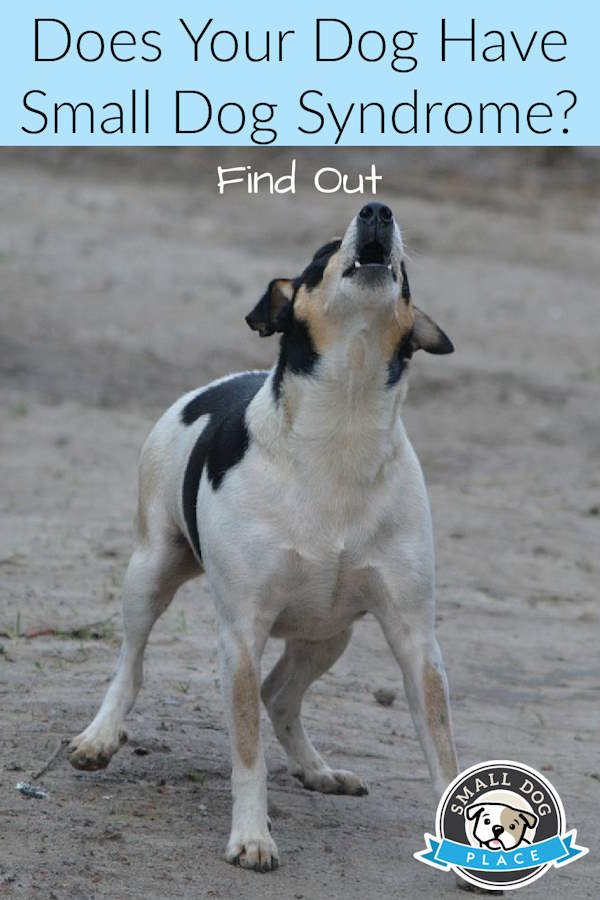- Small Dog Place Home
- Training
- Small Dog Syndrome
Are we really the Cause of
Small Dog Syndrome?
By Janice A. Jones
You’ve probably heard about Small Dog Syndrome, especially if you have a small dog. Nowadays EVERYTHING has to have a name, but defining this so called disease is not so easy.
Most trainers agree that the name refers to a set of undesirable behaviors mostly displayed by small dogs who want to show everyone who’s really the boss. Does this sound like your dog? If so, keep on reading.
May I also suggest that this definition may have been written by a person who prefers BIG dogs? There is much circulating on this so called syndrome on the internet with little appearing in scholarly literature.
The good news is it’s a highly treatable "disease."
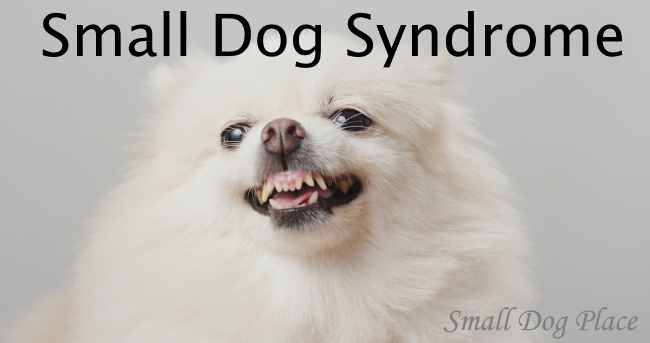 One typical sign of small dog syndrome is aggression.
One typical sign of small dog syndrome is aggression.The Good News About Small Dog Syndrome...
- It does not have a genetic component, so if you’re a breeder, no need for expensive genetic testing
- It is not contagious unless you have more than one dog
- It is cheap to treat, no surgery involved, no lengthy hospitalization
- It does not require you to administer any tricky medications or treatment procedures
- It can be treated entirely with home remedies.
The Bad News About Small Dog Syndrome...
The owner who decides to treat with home remedies must understand and agree with the 5A’s:
- Admit his Canis lupus familiaris (a.k.a. sweet, cute, small dog) is a dog
- Acknowledge his sweet cute small dog is not of the species known as Homo sapien
- Accept responsibility for possibly starting (if dog was purchased as a very young puppy) And/or perpetuating the syndrome
- Add training to the daily routine
- Assume a leadership role
Symptoms of Small Dog Syndrome
As the term syndrome implies, small dogs who may be “suffering” from this malaise exhibit one or more of the following symptoms.
- Jumping up on people
- Begging for food
- Assuming the best and most comfortable place on the human’s bed
- Growling or barking at anyone trying to get close to the dog’s owner
- Demanding to get attention, affection, petting, treats, etc.
- Insistence on going through a doorway first
- Pulling on a leash or refusing to walk on a leash at all
- Nipping at people’s heels
- Refusing stubbornly to listen to commands that have already been mastered
- Barking or whining at a person
- Finding and sleeping on the highest perch he can find
- Separation anxiety symptoms
- Jumping into a human’s lap uninvited
- Growling or barking at other dogs
- Growling or barking at people
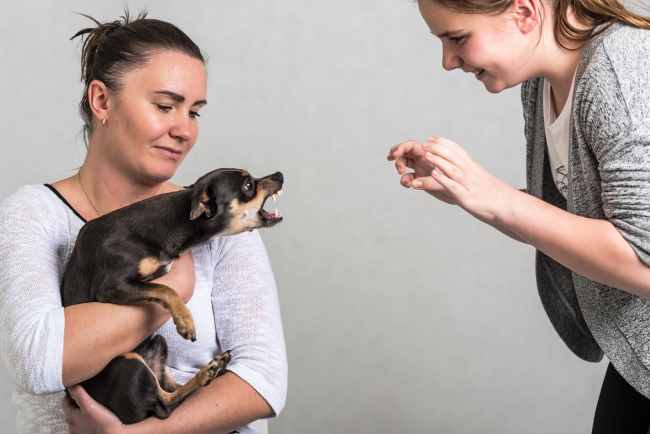
This is basically a list of behaviors that we would prefer not to exist in any dog but can occur as a result of incomplete or inadequate training, socialization and discipline. Small dogs tend to show some or all of these problems because their owners have chosen to allow them to do so.
Large dogs can also be guilty of these behaviors but as a rule do not show them to the extent of tiny dogs. Growling Rottweilers, biting German Shepherds, jumping Bernese Mountain Dogs or pulling Akitas would not make for good pets.
However, some if not all of the behaviors listed above can be tolerated to some extent in a 4 pound dog.
All small dogs do not show all of these symptoms, but if your dog does more than a few, he or she is likely to be deemed a Small Dog Syndrome “victim.”
Luckily there are a few simply cures, but treatment depends on the owner’s willingness to tackle the problem(s).
How does Small Dog Syndrome Start?
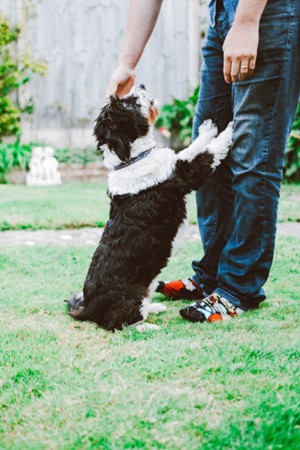
We all love small dogs for many different reasons and often they are treated as infant substitutes. Think about it. The average human infant is born weighing 7 or 8 pounds, the exact size of many small dogs.
They are very easy to pick up, tote around, hold on our lap and snuggle with in our beds. When they whimper or whine, our human reaction is to comfort them just as we would a human infant. Small breed puppies stay small for much longer so it is easy to fall into one of these traps:
...When they jump up on our lap, we think, “Awe, she loves me.”
...When they snuggle up on our pillow at night, we think, “he just wants to be close to me.”
...When they start barking or growling when another person approaches us we think, “they are protecting us.”
...When they bark or growl at another dog, well, “he’s just thinks he’s a big dog!”
...When they refuse to listen to our commands, we think, “She’s just being stubborn!”
...When they show other signs of separation anxiety, we think, “He just misses me.”
...When they become yappy, we think, “she just wants to talk.”
...When they push their head into our hands, we instinctively begin petting them.
Now, if we owned a 70 pound German Shepherd Dog, would we do the same? Would we allow this dog to sit on our lap, sleep on our pillow, start growling or nip at other humans, allow them to destroy our home while we’re away, or refuse to come when called?
Society would probably not allow this and our beloved GSD would not live to be a ripe old age if he growled, barked, and ran away when we called him. So we train our big dogs.
We must also train our small dogs so as to avoid them falling into the small dog syndrome trap. But that is not the complete picture. It becomes a little more complicated than that. We must reframe how we interpret their actions.
Small Dog Syndrome: A Real-life Story
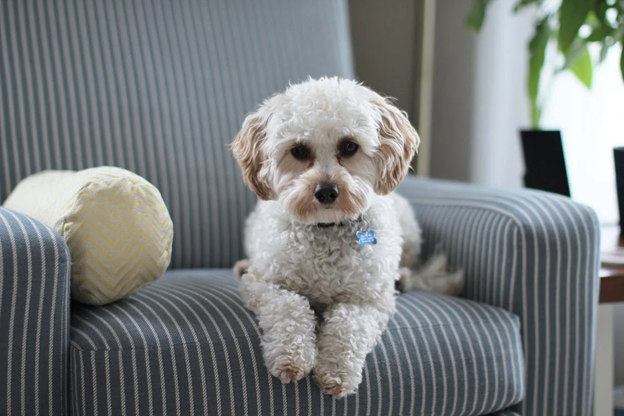
Mrs. Carol Lewis from Great Yarmouth, UK, a Small Dog Place reader, shares her story.
My Teddie is a 2.5 year old Cavapoo. As I am disabled and he was chosen for size, and the fact that he doesn't moult as my husband is allergic to animal hair.
Reading your list of SDS traits has made me realise that Teddie scores almost 100% with his worst problem being barking, at folk that walk past with or without dogs, at vehicles going past (we are a small country lane), but the worse thing is his constant barking at the TV.
If there are animals on the TV he barks and tries to snap at the TV and if you try to stop him he just stands in the middle of the floor and barks - it's as if he's saying how bloody dare you tell me off!!!!
He sleeps on the top of the armchairs or on either mine or my husbands lap.
My biggest fear is that if we were given any indications on how to improve his behaviour my husband won't stick to it and he'll be allowed to continue with his SDS behaviour.
Unfortunately, getting everyone in the household on the same page is not easy as Mrs. Lewis mentioned. I found a segment of the show, It's Me or the Dog, on You Tube that might shed some light on dogs that bark at the television.

Treatment of Small Dog Syndrome
Changing behaviors is neither easy nor impossible, but it does require a small amount of effort on the part of the small breed dog owner to overcome some of those annoying behaviors that have crept up over time. We must be willing to
- Change our thinking about our dog's behavior
- Re-socialize our dogs
- Spend time training each day
- Add discipline to our repertoire of good canine owner skills
We must re-frame or rethink our attitudes...
Take just one example of small dog syndrome: the example of a dog's jumping up on us: In a dog’s mind, jumping is a form of dominance. In the canine world, a male dog will jump on a receptive female during mating, but at any other time, one jumping on another is seen as a form of dominance.
A dog who feels more dominant or wants to show more dominance, will put his paws on the back of another dog. Unless the second dog is very submissive, the act of invading the space of the second dog will often result in a fight. Dogs respect another’s space. When a dog jumps on you without your permission, he is showing dominance over you.
Now, if that same dog that decides to jump on you also growls or barks at another person, instead of thinking that the dog is protecting us, we need to think that the dog Is declaring that we are his property. It gives the often overused phrase, “I’m owned by a Yorkie,” a whole new meaning.
Prevent Small Dog Syndrome: Socialization
As puppies we want to assure that our dogs are introduced to
as many new environments, people, animals and experiences as we can
manage.
Small dogs are usually easy to socialize. We love taking our small dogs out in public, but what do we do? We carry them, either in our arms or in stylish doggie purses. We even buy strollers so they can have a free ride wherever we go. Dogs being carried do not get the same type of socialization that a dog who must walk on a leash receives.
Even our attempts at socialization may unconsciously lead our dog towards Small Dog Syndrome.
Socialization also involves exposed the puppy to the sounds and smells of her environment. Doing this in a loving way without overly comforting the dog if she appears stressed can help her learn to manage her emotions and her social interactions. This helps her by assuring that misplaced fears and anxieties do not set in and become part of her overall personality.
Here, I must define what I mean by “overly comforting the dog.” Good human mothers will be available to their infants and young toddlers to help them move slowly but confidently into the world.
Human mothers act as a home base as the young toddler ventures out, comforting as needed and reassuring, encouraging, and acting like a nurturing cheerleader as the toddler encounters the world.
Canine mothers want their pups to venture out too, but are much less likely to coddle them and shower them with sympathy if they do not at first succeed.
We, as pet parents need to take some lessons from canine mothers and encourage, but not shelter them from experiences that the pup might find stressful. A good example of this is when the puppy cries during a thunderstorm and the human mother picks up the puppy, cuddles and assures him everything will be OK.
We want to protect the pup, but at the same time we want to assure that we do not add extra stress. By overly cuddling him during a thunderstorm actually does the reserve of what we want to achieve. It causes the puppy to think that thunderstorms are an actually reason to be scared and needy.
Prevent Small Dog Syndrome: Training
Basic commands should be taught early and reinforced daily to even the smallest of puppies.
Since tiny puppies usually do not cause the same mayhem of a large rambunctious giant breed puppy, we are inclined to overlook some bad behaviors. Our oversight if done regularly results in an adolescent or adult small breed dog that is poorly behaved.
How can these oversights happen, you might ask? Are small dog owners just poor dog trainers? Very easily…
Training to walk on a leash: Requires that the puppy fit comfortably in a harness. Collars can be dangerous to small puppies. Make sure you purchase your XXXXXXXS size harness, go very easy and take as much time as you can to help your puppy learn to walk on a leash. Sometimes it just easier to wait until the puppy grows into the smallest size available on the market which is usually a XXS.
Sit, Stay: Very important commands, but if the puppy is small enough, the human can simply pick the puppy up; after all, what’s picking up a 2 pound puppy verses a 42 pound puppy?
Leave it: A must to assure that puppy not ingest anything that might harm him. Sometimes it’s easier just to remove the problem than wait for the puppy to learn “Leave It”
I could go on and on with excuses as to why small breed dog owners do not train their babies, but I think you get my point. The truth of the matter is that training IS important but training a 2 pound puppy is different than training a 42-pound puppy and in my next article I will go into more details as how training is accomplished with really small dogs.
Prevent Small Dog Syndrome: Discipline
We all know that puppies need discipline. The classic definition of discipline is training or how to encourage a specific behavior and should not be confused with punishment.
No one disputes the need for training. We want to train our puppies to eliminate themselves in appropriate places, come when they are called, act appropriately around other dogs, and friendly around people. As good small dog owners, we must find time to train, socialize and discipline our tiny dogs.
What Do You Think About Small Dog Syndrome?
Does these symptoms resonate with you? We got more responses from our readers.
Henry's story: A Poodle - Terrier Mix

by Terri Babcock (Seabeck, Washington)
This article busted my poodle-terrier mix. His name is Henry, he has a beautiful, white, soft coat, and he weighs 14 pounds.
We got him from a rescue in Seattle that brings small dogs in from California. Henry was found roaming the streets in the Bay Area.
We have had Henry for about two months, and we tell people no wonder he has attitude, he's a white boy from the hood.
Henry was pretty docile when we first got him, a little barking at first at us, but he had terrific foster parents who loved him dearly.
We do a lot of RVing, and he is the perfect traveling dog. Loves the motor home, likes to go on walks, but we noticed immediately that his barking became increasingly hostile the longer we have had him.
Our adult daughter and her three children live downstairs in our home, and he loves the kids, who are ages 4, 7, and 8. He barks at our adult daughter and any other adults who come over.
The one thing that we can't figure out is that two of the neighborhood boys who come over, who also have dogs, bring out a hostile reaction from Henry. He lunges and nips, lunges and nips, and to one of the boys who is quite small, it was terrifying.
Another thing he does, which I have never seen another dog do, remains silent, almost encouraging people to come up to him, and to those who get in his face, smiling and soft-voiced, he will lunge and snap.
We can't tolerate this behavior. Here are some facts about Henry's day:
Exercise: He takes 1/2 mile walks three-four times a day to explore and do his business. My husband is a runner, and Henry goes with him, probably twice a week, 2 miles worth.
Food: He eats once in the morning, and his food is picked up. He eats again at night, and yet his food is picked up. He has water out all the time.
Separation: When we can't take him with us, he stays in a bathroom, with his bed, blanket, and water.
If we are out for longer than a couple of hours we like to take him with us, however, the weather has gotten cold, and so we don't want to leave him in the car if we go into a store.
The first time we left him, he did fine.
The second time, we came home to a mess. He had somehow gotten a small cut on his pad, or, in jumping, and yanked a bit at a tender spot near the nail, and had bled a lot.
The third time we left him, he did fine again.
Bedtime: He sleeps on the bed, at the foot, and has done so since day one. That is where he slept at the foster family's home.
Playtime: He loves to "mangle" toys, whipping them around and growling "ferociously." He loves to chase things that you throw, and brings them to you to do it again.
Discipline and training: We are not sure what works best for the aggressive barking at strangers.
We have heard flopping him over on his side, grabbing the back of his neck, grabbing his muzzle, etc.
We're still in the process of figuring out what to do. I am particularly attached to him and will do whatever it takes so that he can be a happy, contented dog in our people world.
Last Words about Small Dog Syndrome
Small Dog Syndrome is not a scientific term, but this phenomenon among small breeds carries some basic truths. Not all small dogs fit the definition, but those that do can make life difficult for the human family. There is no genetic basis for these traits. The nuture part of the Nuture/Nature debate wins out in this situation.
Yes, we may be guilty, but we may also have opened our hearts and homes to a rescue that needs a little retraining. Between socialization, training and consistent expectations, we can "cure" this syndrome and enjoy our small dog once again.
Small Dog Syndrome: Pin for Future Reference
About Janice (author and voice behind this site)
Having lived with dogs and cats most of her life, Janice served as a veterinary technician for ten years in Maryland and twelve years as a Shih Tzu dog breeder in Ohio.
Her education includes undergraduate degrees in Psychology with a minor in biology, Early Childhood Education, and Nursing, and a master's in Mental Health Counseling.
She is a lifelong learner, a dog lover, and passionate about the welfare of animals. Her favorite breed for over 50 years has been the Shih Tzu, but she has also lived with Poodles, Maltese, Yorkshire Terriers, Beagles, English Bulldogs, Carin Terriers, and a Cocker Spaniel.
When not writing, reading, and researching dog-related topics, she likes to spend time with her eight Shih Tzu dogs, husband, and family, as well as knitting and crocheting. She is also the voice behind Miracle Shih Tzu and Smart-Knit-Crocheting
Does This Article Deserve Your Thumbs Up?
We always appreciate your support and encouragement. Your thumbs up means so much to us. Please like this article.
If you find this page or any page on Small Dog Place Helpful, or useful in anyway, I'd love it if you would click the small heart found on the bottom right of each page.
You can also share or bookmark this page -- just click on the:

Free Monthly Newsletter
Sign Up for Our Free Newsletter and get our Free Gift to You.
my E-book, The Top 10 Mistakes People Make When Choosing a Dog (and how to avoid them)
